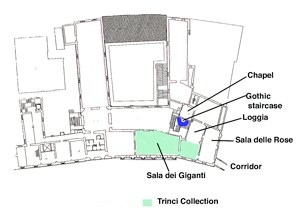
Ugolino III Trinci began an important collection of Roman artefacts under the direction of the humanist Francesco da Fiano. It seems to have been intended to give the impression that his family was of Roman descent. Much of the collection was dispersed after the fall of the Trinci lords in 1439, but a few choice objects are still displayed in two rooms on the piano nobile of Palazzo Trinci.
Room before Sala dei Giganti
Relief of Amore and Psyche (ca. 150 AD)
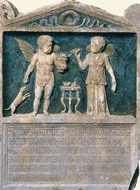
A Latin inscription that was carved on the lower part of the relief in the early 15th century records that Ugolino III Trinci built Palazzo Trinci in the period 1389-1407.
Roman heads (probably 2nd century AD)
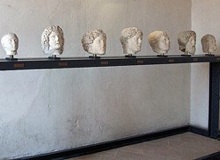
These heads are arranged to represent the seven ages of man. They were placed originally on pediments below and between the arches of the loggia that the Trinci built in what is now called the Palazzetto del Podestà.
Sala dei Giganti
Sarcophagus (3rd century AD)
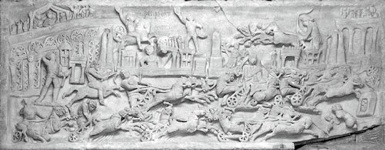
The fine relief on the front of this sarcophagus, which depicts a race involving eight chariots in the Circus of Maximus in Rome, has been in the city since at least the middle of the 16th century. The winner (at the top right) is standing with his whip aloft, and A magistrate with two attendants watches the race from a canopy at the top left. One of the protagonists is about to fall from his chariot, and this might depict the actual demise of the man who was buried in the sarcophagus. Marion Lawrence (referenced below) dated it to the third quarter of the 3rd century.
Sarcophagus (3rd century AD)
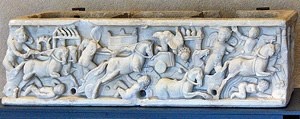
The front of this small sarcophagus depicts a violent chariot race in which the contestants are naked winged putti. The interior of the sarcophagus is divided into three sections, possibly to accommodate funerary urns. Marion Lawrence (referenced below) dated it to the early 3rd century.
Sarcophagus of a child (3rd century AD)
The lovely relief on the front of this sarcophagus shows the garlanded body of a baby being conducted to the next world in a procession of putti, some playing musical instruments. There is a large lion’s head at each of the two front corners.
[Are the following exhibited with the collection?
Relief of Puer Apuliae (13th century)
This relief represents the Emperor Frederick II, who was known as Puer Apuliae (Son of Puglia).
Two reliefs of female heads (13th century)
These two heads, and three others that are known, might have come from the Palatium Imperium that the Emperor Frederick II built in Foligno in [1244]. ]
Read more:
M. Lawrence, “The Circus Relief at Foligno”, in
“Ricerche sull’ Umbria Tardo-Antica e Preromanica: Atti del II Convegno di Studi Umbri (Gubbio, 1964)”, (1965) Perugia, pp. 119-35
Return to Palazzo Trinci.
Return to the page on Museums of Foligno.
Return to Walk II.



